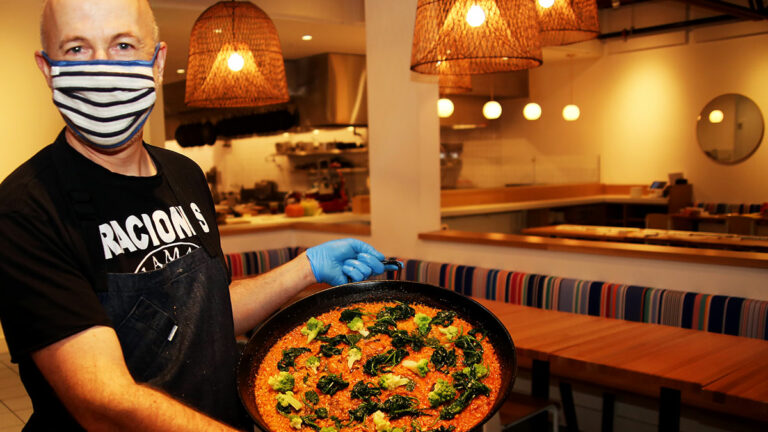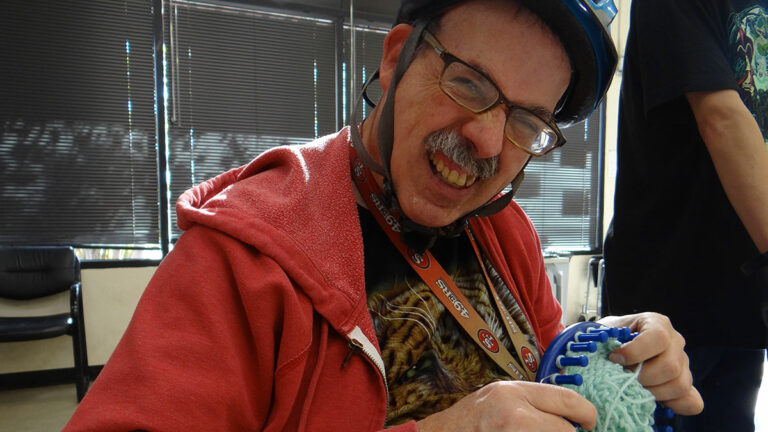After more than three decades of teaching in California state prisons, Claire Braz-Valentine has had her share of surprises. A prison arts Betty Friedan or sorts, Braz-Valentine has helped thousands of prisoners find their literary voices in her writing classes.
“Once there was a new guy in the class, and one of the other guys whispered to him, ‘She’s a feminist, but you are going to grow to love her the way we do,’” Braz-Valentine recalls.
And they did. She’s gotten a marriage proposal and rose bouquets made of toothpaste to prove it.
Now, longtime Santa Cruz local Braz-Valentine is ready for some well-earned downtime. Yet the surprises just keep coming. In October, Senior Arts mentor and longtime colleague Jack Bowers called Braz-Valentine to tell her that she is the recipient of the very first William James Association (WJA) Lifetime Achievement Award.
“I thought, “Oh my god, he is going to ask me to teach someplace, and I can’t say no,” Braz-Valentine recalls. “I felt so terrible. He was calling to tell me about the award.”
The Lifetime Achievement Award was created after Braz-Valentine decided to retire in July. She received a diorama of images and words representing her work in the prison system, complete with a symbolic prison key.
“It’s a fake key—it only unlocks hearts and minds,” Bowers says.
The award will be given again next year, and the nonprofit already has a couple of potential recipients in mind.
“There is a cadre of people who have spent the better part of their lives working in California prison arts since the ’80s who’ve been through the ups and downs and made the program the success it is,” Bowers says. “We want to honor them and their work, as well as people from outside who have made significant contributions.”
With support from the California Arts Council and the California Department of Corrections and Rehabilitation, the WJA has provided Prison Arts Project classes in California prisons for more than 40 years. The classes are taught by professional artists like Braz-Valentine and include writing, music, visual and performing arts. The idea is that through the arts, prisoners can listen and be heard, develop skills that they may not have known before, and have a space to express themselves.
Braz-Valentine initially met with two groups of writers each week in Soledad Prison in the ’80s and ’90s, and went on to teach men, women, and youth prisoners at nearly every California prison. As she became part of the Soledad community, she welcomed the prisoners with open arms—many of whom had not experienced that kind of kindness in a long time, if ever.
“You feel the suffering when walking into a prison. It’s there and it’s heavy. It’s such a blessing to walk into the classroom knowing that you can bring them joy and laughter and art,” Braz-Valentine says. “It’s little miracles like that that help the places that hurt, and what a blessing it’s been to help do that.”
Braz-Valentine co-wrote the play “Women Behind Walls” with her students from the Central California Women’s Facility in Chowchilla, and it has been performed for audiences throughout California and internationally. On a local level, Braz-Valentine has led writing workshops at Santa Cruz Juvenile Hall and worked at Watsonville’s Lakeview Middle School as a playwright in residence for four years, while simultaneously teaching at Soledad.
Braz-Valentine received the WJA Lifetime Achievement Award via Zoom in November with several friends and former students present. Among the attendees was James Wood, a former Solano Prison prisoner and one of Braz-Valentine’s very first students.
“Arts and corrections gave us a venue in which we could be more ourselves; we could be vulnerable,” Wood said at the ceremony. “When you’re in prison, you have to walk around with this persona like you’re a real tough guy and nothing bothers you. But in Arts and Corrections, you become vulnerable, because you have to listen to other people critiquing your work. That vulnerability helped me to become more emotionally mature.”
Braz-Valentine says that the fewer rules you abide by, the better your writing often is. When she began working in the prisons, she didn’t know what a sonnet was—and she didn’t need to. But it was the sense of community and sense of generosity within the prisons that she came to value above all.
The riot at Solano is particularly memorable for Braz-Valentine since she was holding a workshop when it began and her students immediately wanted to make sure she was safe.
“The guys stood there and made a human barricade around me,” she recalls. “I felt like I had nothing to worry about, no one was going to get through that circle. That was one of the most moving things that happened to me. I felt so loved and so respected, and you don’t find that easily behind the walls of a level-four prison.”
Outside of her work, Braz-Valentine has had her own obstacles. As a single mom of three, she says she often pinched pennies to make ends meet, and has lost her family home twice in her life: once when she was in her twenties, and again during the 2018 Camp Fire when she lived in Paradise, California. She lost all of her original works, including many plays and poems that she wrote while leading the prison workshops. But once she set foot in the prison, she says she would leave her outside life at the door and request that the prisoners do the same when they came into the classroom.
“When a guy with a life sentence stands up to read a poem and starts crying, he has hit his own truth,” Braz-Valentine says. “For me to do that for someone, to open the door for them to come through, that is my truth.”
Braz-Valentine wants to set an example for young women and all women that age is not a weakness. Though she is no longer teaching in prisons, she will continue to write with her writing group and write poetry.
“Working on the inside has brought me closer to my own truth than anything else in my life,” she says. “In those workshops, the men and women get closer to their own truth as they write their way out of their darkness. I help them find themselves, and that’s the greatest gift of all.”
For more information on the project, visit williamjamesassociation.org/prison_arts
























